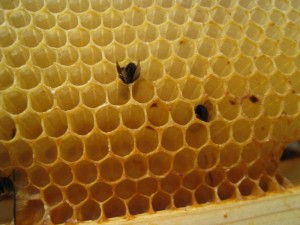
Today (actually, 10 minutes ago), I took on the first major hive inspection of the year, focusing solely on Hive 1, the hive that I have started to call my Geronimo Hive. As per my last post, I had lots of expectations for this inspection. Given the fact that folks to the North of me are talking about reversing already, I went in prepared for Bear. Outside of my normal gear, I brought with me:
- One of my new Nuc’s, in case I found queen cells
- A brood chamber full of frames with foundation, to replace any frames that I removed from this hive, in case I had to
- A top board, as I was definitely going to remove the feeder, which they were not using at all (two idiot bees had ventured into the mix and drowned, of course)
- A capping knife, to cut out any major burr comb that I came across
- A new, painted bottom board (the current screened bottom board is not painted and I want to paint it this year, plus it will be easier to clean it away from the hive.)
The goal of this inspection was to figure out what was going on, find the queen and clean up the bottom brood chamber. For the most part, it was a success.
When I opened up the hive, I removed the feeder and dumped it on the ground nearby. I then removed the Imrie shim and I found one bee eating on the pollen substitute. I think it was wise to drop this in here, although I probably should have done it early (like early February) instead of early March. They had eaten half of a full patty, but now were finished with it. As I found out later, they were bringing in more then enough pollen to feed themselves (and natural pollen surely tastes better then the stuff that I gave them.)
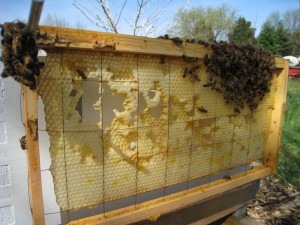
I removed the pollen (tossing it on the ground nearby), and started my inspection of the top brood chamber. There were a fair number of bees about the place, although all of the honey towards the south of the hive was gone (except for a couple of patches). In one frame, I found two bees that appeared to have died of starvation, with their tails sticking out of the comb (of course, I forgot to poke them, so I am only assuming they were dead.) On the north side of the hive, I found 3 to 4 full frames of capped honey. For the most part, this hive body was fairly clean. So, I put it aside and began to examine the motherload.
This time, I lit my smoker and hit them with a few puffs. There were tons of bees (I should have grabbed a picture of them.) I think they covered 6 or 7 frames on the top (and I mean tons – not just a few wandering about – head-to-tail, thick). The frames in this hive have no space on either end, due to my lack of experience last year. One of my goals was to remedy this.
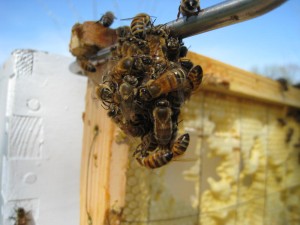
I began to remove the frames, one-by-one. What I found was interesting. What I did not find was irritating. The hive had a couple of frames with lots of pollen and some nectar/honey-being-ripened (partially full cells). One frame, oddly enough, was eaten up a lot. It was like wax moths had gotten to it, but I found no evidence of them in the hive. As I moved through the hive, I came across 4 or more frames that were stock full of capped brood. There were probably one to two frames with eggs and larvae. Fortunately, there were no queen cells (that I found, anyway.) I also did not find that rascal Queen. But, I did not push it, as the frames with the eggs (where I assumed she’d be), had bees a couple of layers thick, all on top of one another. I figured she could easily be in there, out of my sight. I did find one frame with a few capped drone cells, but it couldn’t have been more then 30 or so cells. This was a positive sign, as I also did not see any drones, so we should not be very close to any swarming activity.
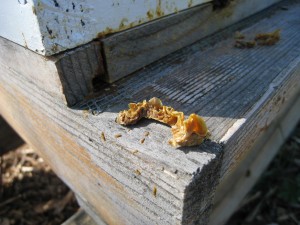
One of the big things that I learned during this inspection was that my problem with the Geronimo hive was not burr comb, but propolis. I see now that the whole ‘cleaning’ aspect of beekeeping escaped me (my wife would say that it escapes me in life). When I was inspecting the frames last year, I should have been using my hive tool to scrape the propolis off of the sides of the frames (where they come together). Since I did not do that, it had built up a lot between several frames, spreading them out substantially. But, I took care of it at this inspection, scraping the sticky stuff off of the side bars of each frame, so they could come together more flush. In the end, I did have a little space on the ends of the frames (although I will have to continue to clean through the warm months to fully defeat this issue.)
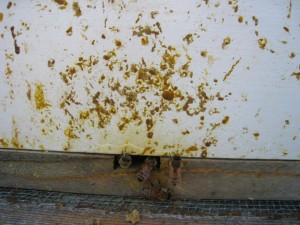
As I was leaving the hive, I took a quick picture of something that has started to bug me over the last month. It seems to me that they are generating a big mess at the front of the hive. Some of this might have been here all along, but I am certain that it was not this thick. I am assuming it is excrement, possibly due to the lemon feeder I had on top these past few weeks. Regardless, I am watching it (they do get problems with having some kind of bee diarrhea, but this doesn’t look at bad as the pictures that I have seen of this problem.)
Also, this last picture was just an oddity. For some reason, bees from the outside frames that I had put on my frame holder decided to show off and do some kind of bee acrobatics. I am not sure if this is normal or not, but my bees are always putting on this kind of show (they did it last year and the young ones from this year appear to have picked up the same trick. I typically have to hold them over the hive and push them off with my hand.

